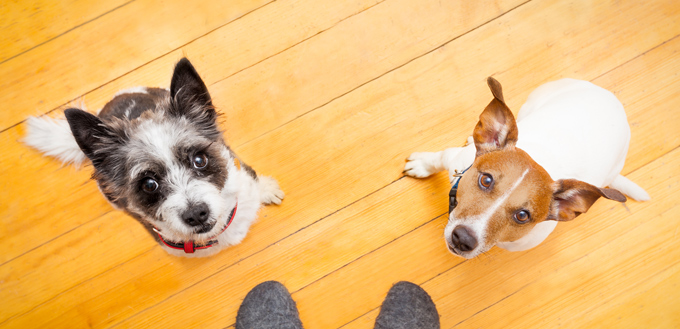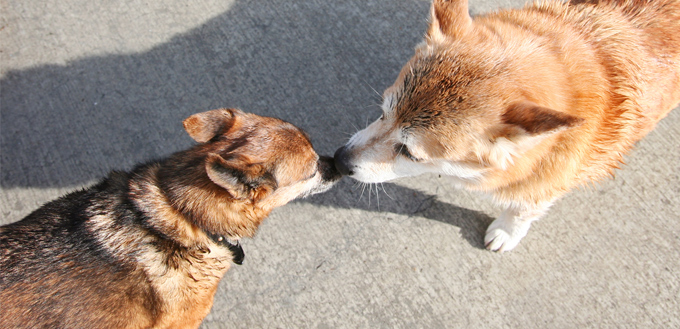Well, what’s there to think about? Double dogs mean double the fun!
True enough. But the question is, are you ready for another dog? Does your dog absolutely need another sibling? Before you go on and get another one of these goofballs, there are some things to consider.
As a dog parent, you must be ready for all the added responsibilities that come with a plus one. Here’s what we think is essential for you to consider before welcoming another pup:

Is Your Existing Dog Ready for a Sibling?
With all that excitement, don’t forget how your current dog might perceive the situation. If you’re still working on behavioral issues with your current dog, bringing in another one would just worsen the problem. Notably, the first few weeks are going to be a nightmare.
Imagine adding another pup to your household, only to end up with both of them learning each other’s bad behaviors. You’ll have to spend double the energy levels, training them into disciplined dogs and you might as well become hopelessly overwhelmed.
So, has your current dog become old, who doesn’t require that extra playtime? Or is the new dog of the opposite sex? If so, you can consider bringing in a new one.
However, note that two female dogs are not a good match because of territory issues.
Do You Have Enough Free Time?
Admit it that your pet dog consumes a lot of your time in a day. Hence, you and your current pet must have well-adjusted to your routine, which by the way, adding a new one might throw everything off. However, your new pup will need individual attention as well as training. If you’re thinking that the new pup will save your time since both of them will play together, and you won’t need to intervene. Well, your perception is not actually correct.
If one of them has any bad habits, you’ll need to train them separately. This, in turn, means that you’ll need to put in more time and effort. In order to do that, you’ll need to ensure whether you have enough room in your schedule to put in the extra effort.
Related Post: Best Dog Training Books
If you’re a true dog lover, you’re more likely to go on with the decision of getting another dog, but we tell you, finding that little extra time on your schedule is not always possible.
Do You Have Extra Space?
Your current pet dog must have taken up an entire corner of your house, so, bringing in another one would mean occupying another corner. Do you really have that extra space? Space isn’t an issue if you own smaller dogs like Pomeranians. But for bigger breeds, you’ll surely need extra room, both indoors and outdoors.
Let’s not forget about the yard. If that’s where you train and play with your dogs, it definitely has to be big enough. They need plenty of room to roam around together. When animals are forced to share a confined space, it is very likely for their temper to flare!
Does Everyone Agree to Your Decision?
Everyone includes everyone in your family. Starting from your partner, your kids, your parents or grandparents (if any), and most importantly your existing pet dog. After all, it’s all about family commitment for which, it’s crucial for you to get everyone’s consent to bringing a second dog. Even if there’s one person who feels that having another dog is an unwelcome burden, they’ll never want to take the responsibility of the dogs.
And about your current dog’s agreement, make sure whether he’s ready for a sibling or perhaps needs one. Of course, he can’t voice it out to you, but you need to understand your pet dog’s body language and his way of communicating. Take note of your dog’s behavior around your neighbor’s dog or other dogs when you take him to the park for a walk. If he reacts assertively, then that’s his way of telling you that another dog might not be a good idea. We know how disappointing that could be, but you can’t sacrifice your current dog’s well-being for the sake of a new dog.

Research the Breeds
Every dog breed has its own personality trait, and their breed generally defines their character and behavior. You must already know about the characteristics of your current dog, so the next thing that you’ll need to do is find another dog who will not have a personality clash with the new one. If your dog is a bit lazy or prefers to sleep 16 hours a day, you wouldn’t want to pair him up with a dog that is very active and hyper, would you? That would end up just annoying each other, leading to chaos in your house. While doing your research, you need to be very careful about the breed you’re considering to bring into your home and look at their differences. Check what type of problems your current dog might face with other dogs.
Consider Your Current Dog’s Health
Has your current dog ever been diagnosed with any health issues? If he’s getting old, he might get diagnosed with something real soon. And that’s what is going to make him not want to play with other dogs or even his very own human.
Bringing home another younger dog, who would pester the older one could be a headache for you. That’s because, you need to keep the younger one away from, the older one, which in turn would mean you having to do all the tasks.
Fostering is a Good Idea
If you’ve checked all the above factors and still feel that you are ready for an adventure of having a second dog, what you can do is foster one first. You and your family can test out what it’s like to have another dog around without committing. By doing so, you will also be helping a dog in need. Who knows, you may end up keeping the foster dog as your pet!
So, Are You Ready for a Second Dog?
What about you? Are you actually prepared to take on an extra commitment of another dog? You may be thinking that having another dog is just the same as having one, but that’s not really the case. Read ahead to know how you can determine whether you are ready or not.
First of all, think about the amount of training that your new dog will require. Every dog needs basic training when they are welcomed to a new home. Don’t be surprised if your new dog needs a little more practice than others. Once you finish training the new dog, the next thing you will need to do is revise on the training for your existing dog. After some time, you can teach both your pet dogs together.
In this way, they will get to learn how to walk along, play with harmony, interact healthily, and so on. Although this process will take some time, it’s still worth it! This is where your family plays their role. Perhaps, one member of your family can make the other dog for a walk while you discipline the new one.
Needless to say, there are numerous extra costs associated with a second dog. You already have a pet dog so you can estimate how much expensive it might get. Now when there’s another dog, it means that there needs to be double the food, dual supplies and not to forget about the doubled vet bills. There are many other variable costs related to dog ownership like dog daycare, dog walker, trainer, and many more. Will you be able to budget all of that?
Worst case scenario, what if the two dogs don’t really get along? You will need to hire a professional trainer to train and modify their behaviors if necessary. The last thing that you would like to do is give back the second dog. That would be so tragic!

Do You Think Your Dog is Ready for a New Housemate?
That’s not so easy to determine. You really need to put your brain into working to think whether your pet dog is ready to welcome another one in the house. Does your dog have a history of getting into fights with other dogs or any other type of dog aggression? Then a second one might not be an excellent idea.
However, if you really want a second one anyway, then the first thing you need to do is consult a dog expert or a behaviorist. The dog expert is likely to help desensitize your pet dog to other dogs and help him become more accepting of other dogs.
Typically, you have to see whether your pet dog is well-trained or not. Otherwise, bringing a second dog is really going to be a lot of work! Having a poorly trained pupper is already bad enough, and given that, another one coming to the family could create chaos. Hence, what we’d suggest is to train the first one properly and then decide to bring the second one.
Plus, let us tell you that bringing a second dog is not the solution to their behavioral problems like separation anxiety or excessive barking. In fact, the arrival of the second one could worsen this problem. Instead of double dogs being double fun, it would then mean double trouble. On top of that, get your current dog diagnosed thoroughly. Talk to your holistic vet about their health condition. It wouldn’t be nice if your current dog has a disease and welcoming another one may lead to having the same problem for the second one. Be cautious!
Additional Tips:
The joy that a puppy brings into a family is unmistakable, for which it’s tough to resist the idea of getting another pooch when you have already been thinking about it for a while. Here are some additional tips to help you work through our decision of adopting a second pooch:
- Allocate time and resources for both your pups carefully. Never make either of them feel that they are being deprived of something.
- Understand that the second pooch is not going to cure separation anxiety for your current dog. If they don’t get along well, it might create a more chaotic situation. Study the breeds well.
- A second dog of the opposite gender works wonderfully. The worst case of two dogs aggressing over each other are two female dogs; the situation might turn out to be a nightmare at times.
- An elderly dog and a rambunctious puppy do not get along with each other in any way. Further complicating the situation, the puppy will take away all the attention, leaving the elderly dog feeling isolated.
- Consider your existing pet dog’s likes and dislikes. Of course, the best choice would be to get a dog who gets along with your current dog’s likes and dislikes. Both of them having two different preferences would empty your pocket faster!
Bottom Line
After you have read the article, we are sure that you are already determined about getting a second dog. Go ahead! If that’s what you’re really into. In every situation, two dogs can always be bought together in peace and harmony. It’s just a matter of time. Additionally, it’s also up to you to take the necessary steps in creating a smooth transition between the animals.
If your current dog is already plenty stimulated and just a little lonely at times, our advice would be to go for it! Certainly, adding a new furry friend would mean twice the work, but if you do it right, it’s just worth it!
How many pet dogs do you have in your house? How do you handle each and every one of them? Let us know in the comments below!
Sources:
- Introducing a New Dog to Your Current Dog, The Ohio State University
- Sherry Woodard, Introducing Dogs to Each Other, Best Friends Animal Society





